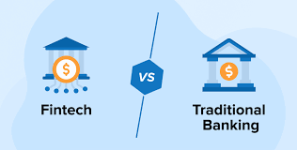In the last decade, the global financial landscape has undergone a dramatic transformation. One of the most significant changes has been the meteoric rise of Fintech companies — agile, tech-driven startups that are redefining the way we think about banking and finance. At the same time, traditional banks are racing to digitize their services and retain their long-standing customer base.
So the question arises: Who will dominate the future — Fintech disruptors or traditional banking giants?
1. The Rise of Fintech:
Fintech companies offer convenience, speed, and innovation. From instant digital payments and personal finance apps to AI-driven credit scoring and robo-advisors, Fintech is reshaping customer expectations. Platforms like PhonePe, Razorpay, and Zerodha in India, or Revolut and Stripe globally, have proven that users prefer seamless, intuitive financial services over legacy systems.
2. Traditional Banks Are Not Sleeping:
While Fintechs innovate rapidly, traditional banks have one major advantage — trust. With decades (sometimes centuries) of history, a strong regulatory framework, and customer loyalty, banks still hold the lion’s share of deposits and credit. Most are investing heavily in digital transformation — adopting AI, blockchain, and cloud computing to stay relevant.
3. Regulation: The Equalizer or the Barrier?
Regulatory compliance is both a challenge and a competitive edge. Fintech startups often struggle to navigate complex regulations, while traditional banks have the resources and compliance teams in place. However, as governments introduce Digital Banking Licenses and regulatory sandboxes, the playing field may shift in favor of Fintechs that can move faster and adapt quickly.
4. Collaboration: The New Competition?
Interestingly, we’re seeing a rise in bank-Fintech partnerships. Instead of competing head-on, many banks are integrating Fintech solutions into their platforms (Banking-as-a-Service). This collaborative model could define the next phase of financial innovation — a hybrid that blends trust with technology.
5. The Customer is King:
At the end of the day, it’s not about banks or Fintechs — it’s about who can deliver the best value to the customer. With rising digital literacy, mobile-first users, and increasing demand for personalized services, the winner will be the one who can offer security, speed, and simplicity.
Conclusion:
The future of finance is not a zero-sum game. Fintech and traditional banks both have roles to play. The real winners will be those who can evolve, innovate, and put the customer at the center. Whether it’s through open banking, embedded finance, or digital-only banking, the financial revolution is here — and it’s only getting started.
So the question arises: Who will dominate the future — Fintech disruptors or traditional banking giants?
1. The Rise of Fintech:
Fintech companies offer convenience, speed, and innovation. From instant digital payments and personal finance apps to AI-driven credit scoring and robo-advisors, Fintech is reshaping customer expectations. Platforms like PhonePe, Razorpay, and Zerodha in India, or Revolut and Stripe globally, have proven that users prefer seamless, intuitive financial services over legacy systems.
2. Traditional Banks Are Not Sleeping:
While Fintechs innovate rapidly, traditional banks have one major advantage — trust. With decades (sometimes centuries) of history, a strong regulatory framework, and customer loyalty, banks still hold the lion’s share of deposits and credit. Most are investing heavily in digital transformation — adopting AI, blockchain, and cloud computing to stay relevant.
3. Regulation: The Equalizer or the Barrier?
Regulatory compliance is both a challenge and a competitive edge. Fintech startups often struggle to navigate complex regulations, while traditional banks have the resources and compliance teams in place. However, as governments introduce Digital Banking Licenses and regulatory sandboxes, the playing field may shift in favor of Fintechs that can move faster and adapt quickly.
4. Collaboration: The New Competition?
Interestingly, we’re seeing a rise in bank-Fintech partnerships. Instead of competing head-on, many banks are integrating Fintech solutions into their platforms (Banking-as-a-Service). This collaborative model could define the next phase of financial innovation — a hybrid that blends trust with technology.
5. The Customer is King:
At the end of the day, it’s not about banks or Fintechs — it’s about who can deliver the best value to the customer. With rising digital literacy, mobile-first users, and increasing demand for personalized services, the winner will be the one who can offer security, speed, and simplicity.
Conclusion:
The future of finance is not a zero-sum game. Fintech and traditional banks both have roles to play. The real winners will be those who can evolve, innovate, and put the customer at the center. Whether it’s through open banking, embedded finance, or digital-only banking, the financial revolution is here — and it’s only getting started.

